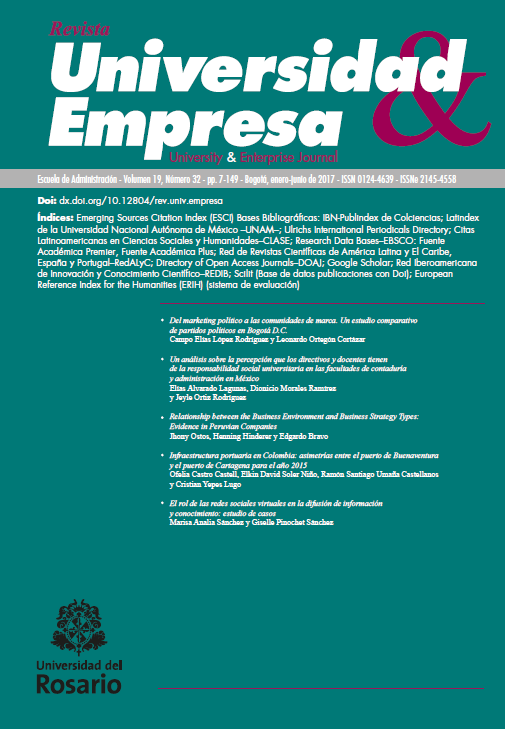El rol de las redes sociales virtuales en la difusión de información y conocimiento: estudio de casos
Barra lateral del artículo
Contenido principal del artículo
Descargas
Marisa Analia Sanchez, Universidad Nacional del Sur
Doctora en Ciencias de la Computación de la Universidad Nacional del Sur (Argentina). Profesora Asociada a tiempo completo del Departamento de Ciencias de la Administración, de la Universidad Nacional del Sur (Bahía Blanca, Argentina).Giselle Pinochet, Universidad Antonio Nariño
Psicóloga de la Universidad Nacional de Colombia. Especialista en Gerencia de Recursos Humanos de la Universidad Jorge Tadeo Lozano. PhD (c) Ciencia Aplicada de la Universidad Antonio Nariño (Bogotá, Colombia).Archambault, A., & Grudin, J. (2012). A Longitudinal Study of Facebook, LinkedIn, and Twitter Use. Proceedings of the SIGCHI Conference on Human Factors in Computing Systems (págs. 2741-2750). Austin: ACM.
Argote, l., & Ingram, P. (2000). Knowledge Transfer: A Basis for Competitive Advantage in Firms. Organizational behavior and Human Decision Processes, 82(1), 150-169.
DANE. (2015). Indicadores básicos de tenencia y uso de TIC en microestablecimientos. Bogotá.
DANE. (2015). Indicadores básicos de TIC en empresas. Bogotá: DANE.
Darr, E., Argote, L., & Epple, D. (1995). The adquisition, transfer and depreciation of knowledge in servece organizations: Productivity in franchises. Management Science, 41, 1750-1762.
Edwards, G. (2010). Mixed-Method Approaches to Social Network Analysis. ESRC National Centre for Research Methods.
Ellison, N., Gibbs, J., & Weber, M. (2015). The use of enterprise social networks sites for lnowledge sharing in distributed organization: the roles of organizational affordances. American behavioral Scientist, 29(1), 103-123.
Etzkowitz, H. (2003). Innovation in Innovation: The Triple Helix of University-Industry-Government Relations. Social Science Information, 42(3), 293-337.
Etzkowitz, H., & Leydesddorff, L. (1995). The Triple Helix -University-Industry-Government Relations: A Laboratory for Knowledge Based Economics Development. EASST Review, 14(1), 11-19.
Fritsch, M., & Kauffeld-Monz, M. (2010). The impact of network structure on oknowledge transfer: an application of social network analysis in the context of regionanl innovation networks. The Annals of Regional Science, 44, 21-38.
Fuerlinger, G., Fandl, U., & Funke, T. (2015). The role of the state in the entrepreneurship ecosystem. Insights from Germany. Triple Helix, 2(3), 1-26.
Geenhuizen, M., & Nijkamp, P. (2012). Knowledge virtualization and local connectedness among young globalized high-tech companies. Technological Forecasting & Social Change, 79, 1179-1191.
Gilsing, V., & Duysters, G. (2008). Understanding novelty creation in exploration networks -Structural and relational embeddedness jointly considered. technovation, 28, 693-708.
Gloor, P., Dorsaz, P., Fuehres, H., & Vogel, M. (2013). Choosing the right friends -predicting success of startup entrepreneurs and innovators through their online social network structure. Int. J. Organisational Design and Engineering, 3(1), 67-85.
Granovetter, M. (1973). The strength if weak ties. American Journal of Sociology, 78, 1360-1389.
Hanneman, R., & Riddle, M. (2005). Introduction to social network methods. Riverside: University of California.
Haythornthwaite, C. (1996). Social Network analysis: An Approach and Technique for the Study of Information Exchange. Library & Information Science Research, 18(4), 323-342.
Hwang, E., Singh, P., & Argote, L. (1 de 2012). Learning to Cross Boundaries in Online Knowledge Communities: Fading of Surface-level and Rise of Deep-level Similarity with Experience. Carnegie Mellon University. Research Showcase @ CMU.
Hwang, E., Singh, P., & Argote, L. (2015). Knowledge Sharing in Online Communities: Learning to Cross Geographic and Hierarchical Boundaries. Organization Science, 26(6), 1593-1611.
Korzynski, P. (2015). Online networking and employee engagement: What current leaders do? Journal of Management Psychology, 30, 582-596.
Leydesdorff, L. (2012). The Triple Helix, Quadruple Helix, ..., and an N-Tuple of Helices: Explanatory Models for Analyzing the Knowledge-Based Economy? Journal of Knowledge and Economics, 3, 25-35.
Luo, S., Du, Y., Liu, P., Xuan, Z., & Wang, Y. (2015). A study on coevolutionary dynamics of knowledge diffusion and social network structure. Expert Systems with Applications, 42, 3619-3633.
Ministerio de Tecnologías de la Información y las Comunicaciones. (10 de 7 de 2015). Caracterización de las MIPyMEs Colombianas en relación con las TIC. Bogotá. Recuperado el 10 de 11 de 2015, de http://www.mintic.gov.co/portal/604/w3-article-11147.html
Morrison, E. (2002). Newcomers´relationship: the role of social network ties during socialization. Academy of Mangement Journal, 45, 1149-1160.
Naciones Unidas. (2009). Clasificación Industrial Internacional Uniforme de todas las actividades económicas (CIIU). Revisión 4. Departamento de Asuntos Económicos y Sociales. Nueva York: Naciones Unidas.
Narayanan, M., Asur, S., Nair, A., Rao, S., Kaushik, A., Mehta, D., . . . Lalwani, R. (2012). Social Media and Business. Vikalpa: The journal for Decision Makers, 37(4), 69-111.
Oostervink, N., Agterberg, M., & Huysman, M. (2016). Knowledge Sharing on Enterprise Social Media: Practices to Cope with Institutional Complexity. Journal of Computer-Mediated Communication, 21, 156-176.
Pan, Y., Xu, Y., Wang, X., Zhang, C., Ling, H., & Lin, J. (2015). Integrating social networking support for dyadic knowledge exchange: a study in a virtual community of practice. Information & Management, 52, 61-70.
Phelps, C., Heidl, R., & Wadhwa, A. (2012). Knowledge, Networks, and Knowledge Networks: A Review and Research Agenda. Journal of Management, 38(4), 1115-1166.
Shin, S., Lee, K., & Hall, D. (2014). exploring Facebook Users´ Continuous Visiting Behaviors: Conceptual Incorporation of Facebook User Perceptions toward Companies´Facebook Fan Page Usage. Twentieth Americas Conference on Information Systems. Savannah.
Skeels, M., & Grudin, J. (2009). When social networks cross boundaries: a case study of workplace use of Facebook and LinkedIn. Proceedings of the ACM 2009 International Conference on Supporting Group Work (págs. 95-104). Florida: ACM.
Van Alstyne, M., & Brynjolfsson, E. (2005). Global village or CyberBalkans: Modeling and measuring the integration of electronic communities. Management Science, 51(6), 851-868.
Yin, R. (1994). Case Study Research: Design and Methods. Thousand Oaks: Sage Publications.



